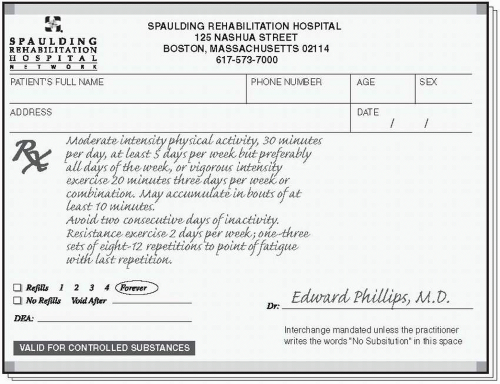Illness or Condition
Definition
Prevalence and Incidence
Other treatments (medication, surgery, etc.)
Testing and screening, with reference to Chapter 3
Precautions
Exercise Prescription: Modifications from general recommendations
Arthritis
Hypertension
Overweight/Obesity
Osteoporosis
Pregnancy
Cancer
Cardiovascular Disease
Older Adults
Depression
Diabetes
Weight loss
Education in self-management
Patient support groups
Appropriate footwear to reduce shock to lower extremities
Occupational Therapy
Physical Therapy
Assistive devices (canes, walkers, bracing)
Non-steroidal anti-inflammatory medications
Disease modifying medications for rheumatoid arthritis
Surgery for joint debridement and total joint replacement
Strengthening and maintenance of muscle strength around joints from resistance training
Reduced joint stiffness from stretching and physical activity
TABLE 13.1 Classification and Management of Blood Pressure for Adults† | ||||||||||||||||||||||||||||||||||||||||||
|---|---|---|---|---|---|---|---|---|---|---|---|---|---|---|---|---|---|---|---|---|---|---|---|---|---|---|---|---|---|---|---|---|---|---|---|---|---|---|---|---|---|---|
| ||||||||||||||||||||||||||||||||||||||||||
Weight loss
DASH Diet (Dietary Approaches to Stop Hypertension)
Medications
cardiac dysrhythmias. Diuretics and beta-blockers may cause hypoglycemia in some individuals (see Diabetes section, below). These same medications may affect thermoregulatory function and cause heat intolerance. Exercise capacity may be reduced by beta-blockers. Exercise should be stopped for SBP ≥250 mm Hg and/or DBP ≥115 mm Hg.
Medications
Bariatric surgery
Weight loss regimens through caloric restriction
Support groups
exercise alone won’t get the weight off, but exercise is essential to keeping the weight off.
are elderly. Hip fractures are associated with the greatest increased risk of death and disability.
Decreased osteoporotic fractures by increased peak bone mass
Slowed rate of bone loss with aging
Higher bone mass achieved in childhood, adolescence, and young adulthood through adequate physical activity is maintained into adulthood
Dietary or supplementation of calcium
Vitamin D supplementation and/or exposure to sunlight
Hormone Replacement: Estrogen and progesterone
Medications
effort required to exercise (23). This increased energy consumption results in a higher [V with dot above]O2 (oxygen consumption), cardiac output, and stroke volumes; however, maximal heart rate appears to remain unchanged (23). Increases in energy expenditure also result in a greater difficulty removing heat from the body. Table 13.2 provides some tips to help pregnant women avoid overheating while exercising.
Maintenance of prenatal aerobic and musculoskeletal fitness levels
Prevention of excessive maternal weight gain
Facilitation of labor and recovery from labor
Promotion of good posture
Prevention of gestational glucose intolerance
Prevention of low back pain
by the same group as the PAR-Q (see Chapter 3) (22). This easy-to-use screening tool is freely available at http://www.csep.ca/forms.asp.
TABLE 13.2 Exercise Tips for Pregnant Women | ||||||||||||||||||||||||||||||
|---|---|---|---|---|---|---|---|---|---|---|---|---|---|---|---|---|---|---|---|---|---|---|---|---|---|---|---|---|---|---|
| ||||||||||||||||||||||||||||||
Stay updated, free articles. Join our Telegram channel

Full access? Get Clinical Tree







